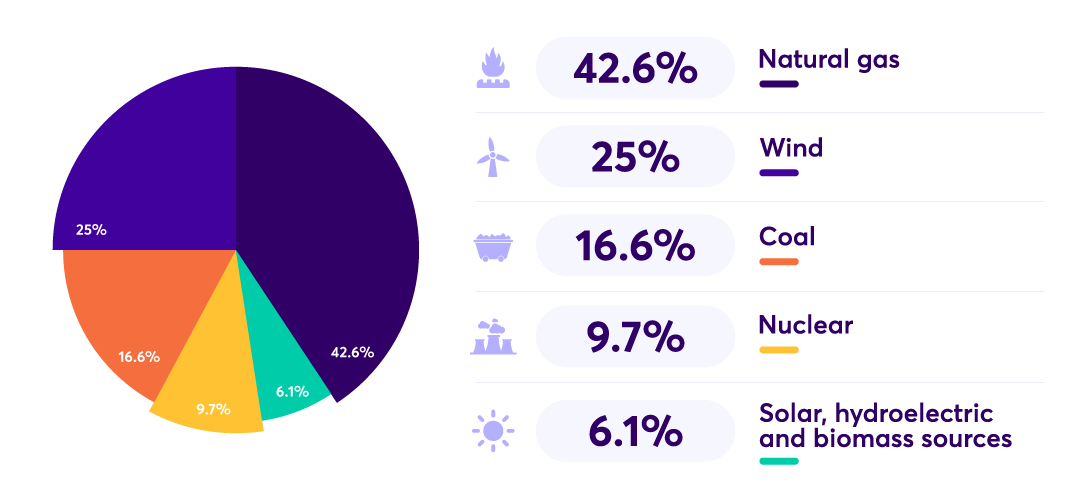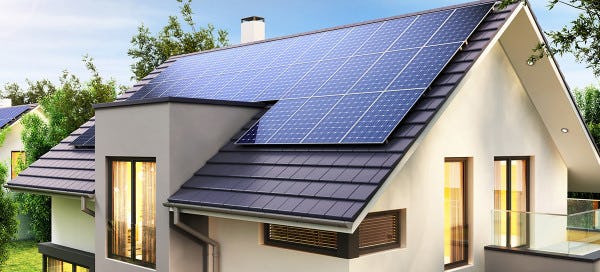Texas Renewable Energy: A Guide to Green Power Solutions
How is Texas faring in terms of renewable energy resources? Well, as it turns out, the Lone Star State is unrivaled among other states in America for generating energy from renewables! According to SaveOnEnergy.com, Texas produces more than 6.5 million megawatt hours of electricity from renewable sources each month. No other state is even close.
Renewable sources that were measured in the study included wind, solar, hydroelectric, geothermal, wood and wood-derived materials and other biomass – the six categories designated as renewable by the U.S. Energy Information Administration. Let’s take a closer look at these and other renewable resources for energy production, and how they’re being used (or may be used, in the future) in Texas.

Wind Energy
Texas is the country’s leading state when it comes to wind power, with nearly 45,000 megawatts of capacity – more than triple the capacity of second place Oklahoma. Our state has the perfect mix of conditions for wind energy production, including enormous open tracts of land, favorable wind patterns, and highly respected research institutions that have been pioneering wind energy innovation since the 1970s.
With miles and miles of turbines visible from highways, onshore wind farms are used to generate electricity on land, and are commonly found in open plains and rural areas. Here, farmers and landowners often rent space for the turbines to wind companies, as the power generation does not interfere with farming. Offshore wind farms – which install turbines in bodies of water where coastal winds are strong – are also expected to grow in the future, with one such farm proposed for the Gulf of Mexico near Galveston, bringing the potential to power 2.3 million homes.
Solar Energy
Growth in solar capacity in recent decades has also helped position Texas as a renewable energy leader. According to the Solar Energy Industries Association, through 2022 our state was the second-biggest producer of solar energy after California. As the prices of solar panels and related equipment continue to drop, we could see even more solar production.
The generation of energy using photovoltaic (PV) solar panels is the most widely known method of solar power production. These panels convert sunlight directly into electricity, and are used in both residential and commercial installations, whether as a field of panels or installed on rooftops. Large-scale solar power plants also use panels but add mirrors and lenses to concentrate the sunlight into a receiver, using a process called “Concentrated Solar Power” (CSP).
Did you know that using sunlight to heat water is also a form of renewable energy generation? Sometimes called solar domestic hot water systems, these can be a cost-effective way to produce hot water for homes. Even if other water heaters are used (powered by electricity, gas, or another fuel), solar hot water systems can give you some free hot water every day.
Biomass Energy
Burning waste to create energy is another means of renewable power generation. According to the Texas Commission on Environmental Quality, in 2022 waste-to-energy facilities generated and sold 220 million kilowatt hours of power.
The majority of this waste – about 80% – comes from wood and wood waste, most commonly mulch, which is burned to generate heat and power in both industrial boilers and home heating systems. In rural areas, agricultural residue also makes a great fuel for both heating and power generation: crop residues and animal waste are plentiful and can be converted into energy. Some landfills even capture methane emissions and use it to generate both electricity and heat.
Another source of waste is “municipal solid waste” – also known as garbage. This is made up of everyday items that are thrown away by both homes and businesses, from furniture and clothing to bottles and cans, food scraps, yard trimmings, and more. In specialized plants, these materials can be burned or gasified to convert the waste into energy.
The renewable natural gas that is derived from biomass or other renewable resources is a pipeline-quality gas that can be used in all applications that use conventional natural gas. This means that it can power homes, businesses, manufacturing, and even vehicles.
Dedicated Energy Crops
Some farmers grow specific crops for use as a source of bioenergy for biomass power plants. According to a report from TexasAgriculture.gov, leading nontraditional agricultural feedstocks include algae, castor, perennial grasses, and others.
Algae has tremendous potential for producing biofuels, in part because it only takes 48 to 72 hours to regenerate, making it a wonderfully renewable resource. Castor is another plant that is growing in popularity for biomass power production, because it has a very high drought and salinity tolerance. Castor oil works well in jet fuel and other military applications that require stability and reliability across a wide variety of climates and conditions.
Hydropower
The U.S. Department of Energy’s 2023 U.S. Hydropower Market Report stated that in 2022, hydropower contributed nearly 29% of renewable energy across the country, and 6% of all electricity in the U.S. There are 26 hydropower plants in Texas, serving about 2.9 million Texans in 2019; one of their most important functions is during times of energy crisis such as power outages, when these plants direct the electricity they generate to areas of need.
Hydroelectric power also can be generated at a much smaller scale, such as in rural, remote, or “off the grid” areas to provide a local power supply. This can even be done at a micro level: according to the Department of Energy, microhydropower can be one of the simplest and most consistent forms of renewable energy. If your property contains flowing water, you can build a small hydropower system, which can generate up to 100 kilowatts of electricity.
Geothermal Energy
The core of the earth is the same temperature as the surface of the sun: almost 11,000 degrees Fahrenheit! This means that drilling just about anywhere in the world, if you go deep enough, will bring you to boiling temperatures. Even at relatively shallow depths such as six miles down, there is sufficient heat for power generation.
A landmark study by the University of Texas tells us the amount of heat energy beneath our feet is estimated to be many thousands of times larger than what we would need to power not only Texas, but the world. Just think of how the oil and gas industry has powered the world through the industrial revolution and into modern times – yet, compared to geothermal heat, fossil fuels are a much smaller and more limited resource.
Geothermal heat pumps are the most common form of tapping heat in the earth, using the earth’s consistent and constant temperature to heat and cool homes and commercial buildings. Just a few feet below the earth’s surface, the ground is a relatively constant temperature – depending on the latitude of the location, these temperatures can range from 45 to 75°F. As is the case with a cave, this ground temperature is warmer than the air above it during the winter and cooler than the air in the summer. Geothermal heat pumps exchange heat with the earth through a ground heat exchanger – enabling them to heat, cool, and even supply a home or business with hot water.
At a larger scale, enhanced geothermal systems (EGS) extract heat from much deeper underground, using it to generate electricity in geothermal power plants.
Biofuel
Not all biofuels are equally beneficial to the environment. The worst require mass cultivation of corn and soy, or contribute to deforestation, while the best use waste products without encouraging unsustainable practices. One popular example of the latter is converting cooking grease into fuel.
Biodiesel mixes vegetable oils and animal fats with ethanol alcohol, to be used in diesel engines on its own or mixed with regular diesel. Texas has three biodiesel plants that produce around 300 million gallons each year, making it the second largest biodiesel producing state in the union. Our state is also one of the largest consumers of biodiesel.
Wave and Tidal Energy
Energy that is generated by incoming waves and tides has a demonstrated and proven track record for more than 20 years. And with more than 400 miles of Gulf of Mexico coastline, our state is well positioned to employ both wave energy converters – which change energy from ocean waves into electricity – and tidal stream converters – which are used in tidal estuaries and other coastal areas.
This form of energy, called “hydrokinetically generated power,” is consistently reliable. Currents, tides, and waves flow all day, every day of the year, making them more stable than other clean energy sources, which can be hampered by cloudy days or freezing weather. No matter what the season or time, the tides and waves keep rolling into shore.
Advanced Battery Storage for Renewable Energy
By their nature, renewable energy sources such as wind and solar can be affected by daily and seasonal cycles and fluctuations, so they do not consistently produce energy at all hours. This is called “intermittency.” Coal and natural gas power plants are able to generate constant sources of energy, but do so at great cost to the environment.
Thankfully, the development of high capacity batteries that are capable of storing tremendous amounts of power are a key part of grid modernization, enabling power grids to tap into those reserves when energy production dips. High tech batteries are even an important component of home solar and wind systems, storing electricity for when you need it but the sun is not shining or the wind is not blowing.
An Emerging Technology: Hydrogen Fuel Cells
According to an informative article from March of 2024 in the Texas Tribune, hydrogen is a fuel that can be produced in ways that create little to no greenhouse gasses, providing an eco-friendly fuel for cars, planes, ships, and semi trucks, as well as powering energy-intensive industries such as the manufacturing of steel. Burning it directly can create harmful emissions, but when used in fuel cells, hydrogen emits only water.
Companies are currently racing to develop the cleanest, most efficient and effective hydrogen fuel cells. Part of the challenge is that some methods of extracting hydrogen release carbon dioxide into the atmosphere, while others that release no greenhouse gasses – such as capturing the carbon dioxide or splitting hydrogen from water – can be very expensive. The federal government is offering billions of dollars in tax credits to kickstart production of hydrogen from gas with carbon capture or from water – including up to $1.2 billion for projects in Texas and Louisiana that plan to make hydrogen largely from natural gas.
All Renewable Energy, from Rhythm Energy
At Rhythm Energy, we’re powered by 100% renewable energy, because we share the same values as our customers: providing reliable, cost-effective clean energy that’s better for the planet. We even have 100% solar plans like Texas Shine and 100% wind energy plans like Texas Breeze, so your energy consumption can match your priorities.
FAQ
What is the biggest renewable resource for energy in Texas?
Wind power is far and away our biggest renewable energy resource, thanks to our open plains and miles and miles of wind farms. In fact, Texas produces the most wind energy of any state in the United States, by a long shot.
How does Texas support solar energy production?
Our state is the second-biggest producer of solar energy, after California. As the prices of solar panels and related equipment continue to drop, we could see even more growth in solar production – whether it is on homes, at a grand scale through concentrated solar power, or even through the rise in the use of solar water heaters.
Is biomass energy production considered green energy?
It is considered renewable energy generation, because it takes existing waste and converts it into energy – whether it be agricultural waste, household waste, or even wood byproducts.
What are some emerging technologies driving renewable energy production in Texas?
Wave and tidal energy capture, hydrogen fuel cells, and advanced battery systems are helping push renewable energy generation forward in our great state. As these and other technologies continue to develop, we will be able to produce an even greater percentage of the energy we use from earth-friendly sources.




